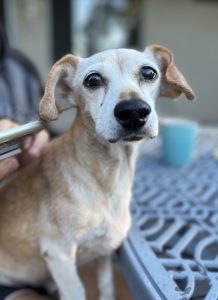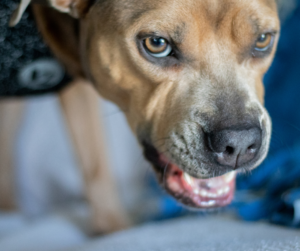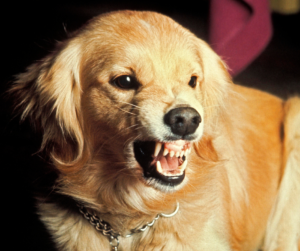Michael Baugh CDBC CPDT-KSA
It’s called emotional contagion. The idea is that dogs perceive our emotions and then experience an emotional response themselves. Affective empathy takes it a bit further. Dogs can actually feel our emotional experiences. (Karen London PhD, Bark Magazine). It turns out that there’s plenty of evidence to suggest both of these ideas are true. (Google “emotional contagion dogs.” Use google scholar for more in-depth results).
 Of course, a lot of us have suspected this for a long time. Many of us routinely experience it. Dogs just get us. They have feelings with us. They are little mirrors into our emotional lives. It’s an amazing thing to witness as a dog behavior consultant. I meet a ton of people and their dogs every year. Sometimes it’s very clear to me that a dog who is suffering emotionally lives with a human who is also suffering. It’s heartbreaking sometimes. It’s also awe inspiring to see such a powerful bond playing out in real time right in front of me.
Of course, a lot of us have suspected this for a long time. Many of us routinely experience it. Dogs just get us. They have feelings with us. They are little mirrors into our emotional lives. It’s an amazing thing to witness as a dog behavior consultant. I meet a ton of people and their dogs every year. Sometimes it’s very clear to me that a dog who is suffering emotionally lives with a human who is also suffering. It’s heartbreaking sometimes. It’s also awe inspiring to see such a powerful bond playing out in real time right in front of me.
Folks ask all the time, “is he (the dog) feeding off my anxiety.” Well, maybe. We certainly know our feelings show up in our dogs’ emotional lives. But, the answer, in my opinion, is not to blame ourselves. Too many trainers do that, as if our anxiety is some form of mystical “energy” that we control. Instead, I think we should all make space to compassionately look at the big picture. How is my dog doing? How am I doing? For me this means regular counseling so I can develop and maintain my own emotional and behavioral flexibility. You probably know how passionate I am about our dogs’ behavioral flexibility. The Magazine Psychology Today has a great online resource for finding a therapist that is right for you. Staying emotionally and behaviorally flexible is good for all of us (like yoga for our feelings).
Does this mean we all have to be in therapy? Um, maybe. Does it mean we all have to have our lives in perfect order before we can have a dog or help the dog we already have? No, of course not. In fact, many dogs have emotional and behavioral problems completely separate from our own human issues. The research suggests that our dogs can experience our feeling. It does not say that every dog’s behavior issue (including fear and aggression) is somehow tied to our own disfunction. It’s not. By far most of the clients I meet are joy-filled and highly functioning. And, some of them have grumpy dogs. Remember? No blame.
What does all of this mean for those of us who have dogs with fear, anxiety, or aggressive behavior? We all like some concise tips and I’m happy to add some information to the mix.
Think well of your dog. The things we tell ourselves about our dog are important. Instead of getting stuck in negative thoughts and frustration, let’s remind ourselves of all that is good about our dog. It will help our training. It will also set us up to notice progress as it comes. How we think about our dog is so important. That’s why I list it first.
Choose joy. It’s not always easy but I think it always helps. When we are training let’s make a decision to smile, say kind things to our dogs, and use food. Even though our bigger behavior goals with our dog might be challenging, individual training session can be light and fun.
Take breaks. If you’re feeling tense or angry during a training session, stop. Take a break. It’s okay. Your dog will definitely sense that tension and anger and it will affect their learning. Take a long break if you need to. We’ve all been there. No blame. Just circle back later.
Let me help. That’s what our journal is for. I’m not qualified to offer human therapy. At the same time I am a fellow human being. I can definitely help us keep things on track with training and offer coaching along the way. Complicated behavior plans related to fear and aggression can sometime feel overwhelming and isolating. Of course, you’re not alone. And, it’s my job to clarify what seems complicated and ease frustration along the way.
One last story. I’ll keep it brief. I learned a long time ago why I gravitated toward helping fearful and sometimes angry dogs. It’s because it helped me. Some of you have heard me joke aloud with your dog, “I get it honey, people scare me too.” Like all jokes there was some truth in that. So, we break things down for our dog; we set them up to succeed; we let them take on new experiences at their own pace; we provide support and feedback to help them. All that feels very familiar to me personally. In time, almost always, feelings start to change little-by-little. In them. In us. What a joy it is to see that happening. What a beautiful lesson it is to experience through our dogs.
Change. It’s the stuff of life. Human emotions reflected in our beloved dogs. The hard work that softens them, that softens us, a team in transition together. It’s amazing how our feelings affect our dogs. But, oh how our dogs affect our feelings. It’s a gift for which I am ever so grateful.
Michael Baugh is a behavior consultant and dog trainer in Houston, TX. He works with clients all over North America and specializes in aggressive dog training.


